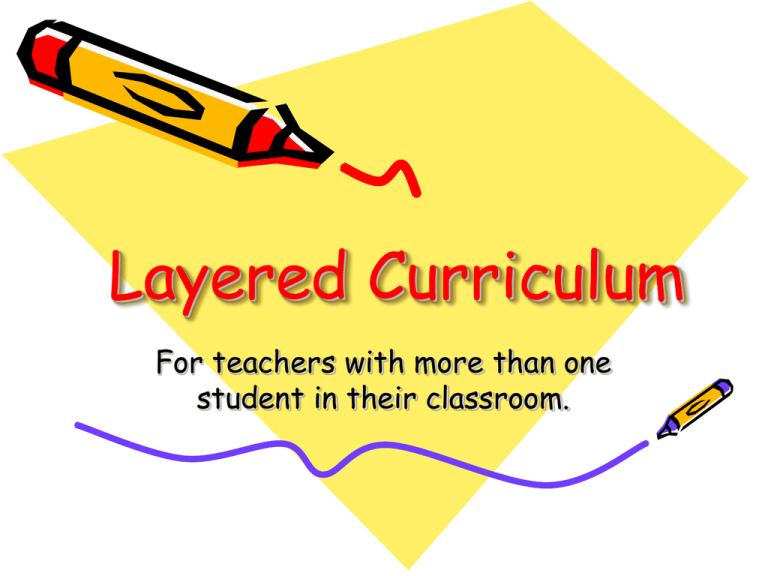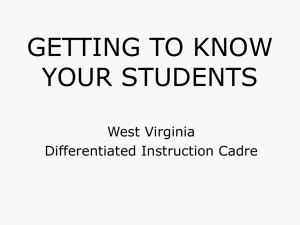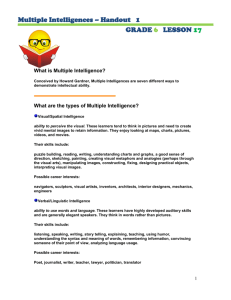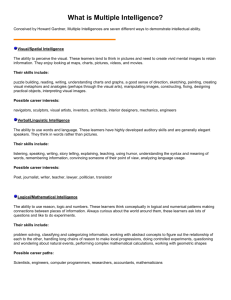power point overview of Layered Curriculum
advertisement

Layered Curriculum For teachers with more than one student in their classroom. How many “regular” students are in a regular classroom? 3 with IEPs 3 “unidentified” 1 with ADD 1 ELL 6 visual 4 aural 2 read/write 12 kinesthetic Does one size fit all? • Or, is there a better way to meet the needs of all students in a “regular” classroom? Tools of the Trade • Learning Styles – Rita Dunn & Others • Multiple Intelligences – Howard Gardner • Mind Styles – Anthony Gregoric • Blooms Taxonomy • Instructional Strategies – Robert Marzano • Differentiated Instructional Model • Cooperative Learning – Johnson & Johnson Key Concept #1 • Voice and Choice – Students want control. – If you don’t offer it, they take it. Paradigm Shift Choice requires knowledge Knowledge of SELF Key Concept #2 Novelty • “If students know what to expect before coming to class, you have already lost them.” -Dr. John Penick Key Concept #3 Accountability – Students learning rather than just doing – Students responsible for their own learning Key Concept #4 • Personal Needs Met – – – – Hunger Thirst Security Sleep Key Concept #5 • Encourage Higher Level Thinking – Bloom’s taxonomy • Remember • Understand • Apply • Analyze • Evaluate • Create The of Layered Curriculum • Layer C -- Remember and Understand – Basic content & vocabulary • Layer B – Apply and Analyze – Labs & projects • Layer A – Evaluate and Create – Critical thinking & problem solving Layer C – for Visual Learners • Read the chapter and explain the illustrations • Find a magazine article and highlight the key ideas • Complete a concept map for the topic • Watch video and do follow-up assignment Layer C—for Auditory Learners • • • • • Listen to the book on tape. Listen to lecture. Watch/listen to video. Debate concepts in a group of four. Read a magazine article with a friend taking turns reading out loud. Layer C—for Readers and Writers • • • • Read the text and answer questions Write a chapter summary Listen to lecture and take notes Complete “Guided Reading” worksheets • Read supplemental articles and write a report Layer C—for Kinesthetic Learners • Complete a scavenger hunt through the chapter. • Read case studies and highlight key concepts. • Play vocabulary charades with a friend. • Play chapter trivia games. Layer B – Apply and Analyze • • • • • • Activities Labs Webquests Videos Presentations Write test questions and provide an answer key Layer A – Evaluate and Create • Pose critical thinking questions • Extensive projects • Individualized Research Questions • Interdisciplinary projects So where do I start? 1. 2. 3. 4. Pick a unit to think about. Pull out all of your resources. Divide them up for C, B, & A layers. Look at meeting learning preferences and intelligences. Visual/Spatial Intelligence ability to perceive the visual. These learners tend to think in pictures and need to create vivid mental images to retain information. They enjoy looking at maps, charts, pictures, videos, and movies. skills include: puzzle building, reading, writing, understanding charts and graphs, a good sense of direction, sketching, painting, creating visual metaphors and analogies (perhaps through the visual arts), manipulating images, constructing, fixing, designing practical objects, interpreting visual images. Verbal/Linguistic Intelligence ability to use words and language. These learners have highly developed auditory skills and are generally elegant speakers. They think in words rather than pictures. Their skills include: listening, speaking, writing, story telling, explaining, teaching, using humor, understanding the syntax and meaning of words, remembering information, convincing someone of their point of view, analyzing language usage. Logical/Mathematical Intelligence ability to use reason, logic and numbers. These learners think conceptually in logical and numerical patterns making connections between pieces of information. Always curious about the world around them, these learner ask lots of questions and like to do experiments. Their skills include: problem solving, classifying and categorizing information, working with abstract concepts to figure out the relationship of each to the other, handling long chains of reason to make local progressions, doing controlled experiments, questioning and wondering about natural events, performing complex mathematical calculations, working with geometric shapes Bodily/Kinesthetic Intelligence ability to control body movements and handle objects skillfully. These learners express themselves through movement. They have a good sense of balance and eye-hand coordination. (e.g. ball play, balancing beams). Through interacting with the space around them, they are able to remember and process information. Their skills include: dancing, physical co-ordination, sports, hands on experimentation, using body language, crafts, acting, miming, using their hands to create or build, expressing emotions through the body Musical/Rhythmic Intelligence ability to produce and appreciate music. These musically inclined learners think in sounds, rhythms and patterns. They immediately respond to music either appreciating or criticizing what they hear. Many of these learners are extremely sensitive to environmental sounds (e.g. crickets, bells, dripping taps). Their skills include: singing, whistling, playing musical instruments, recognizing tonal patterns, composing music, remembering melodies, understanding the structure and rhythm of music Interpersonal Intelligence ability to relate and understand others. These learners try to see things from other people's point of view in order to understand how they think and feel. They often have an uncanny ability to sense feelings, intentions and motivations. They are great organizers, although they sometimes resort to manipulation. Generally they try to maintain peace in group settings and encourage co-operation.They use both verbal (e.g. speaking) and non-verbal language (e.g. eye contact, body language) to open communication channels with others. Their skills include: seeing things from other perspectives (dual-perspective), listening, using empathy, understanding other people's moods and feelings, counseling, cooperating with groups, noticing people's moods, motivations and intentions, communicating both verbally and non-verbally, building trust, peaceful conflict resolution, establishing positive relations with other people. Intrapersonal Intelligence ability to self-reflect and be aware of one's inner state of being. These learners try to understand their inner feelings, dreams, relationships with others, and strengths and weaknesses. Their Skills include: Recognizing their own strengths and weaknesses, reflecting and analyzing themselves, awareness of their inner feelings, desires and dreams, evaluating their thinking patterns, reasoning with themselves, understanding their role in relationship to others Resources • www.help4teachers.com • www.brains.org • http://www.teachersworkshop.com/t wshop/sousa.html • http://www.varklearn.com/english/index.asp • http://nerds.unl.edu/layered








